
FIGURE 3-16:Capacitors come in many shapes and sizes.
Capacitors come in several different varieties, the two most common being ceramic disk and electrolytic . The amount of capacitance of a given capacitor is usually measured in microfarads, abbreviated μF. As a starting assortment of capacitors, I suggest you get at least five each of the following capacitors:
Ceramic disk: 0.01 μF and 0.1 μF
Electrolytic: 1 μF, 10 μF, 100 μF, 220 μF, and 470 μF
 As with resistors, you can purchase kits with a wide variety of assorted capacitor values. For about $15, you can get 500 or more capacitors in a range of useful values.
As with resistors, you can purchase kits with a wide variety of assorted capacitor values. For about $15, you can get 500 or more capacitors in a range of useful values.
A diode is a device that lets current flow in only one direction. Figure 3-17 shows an assortment of various types of diodes.
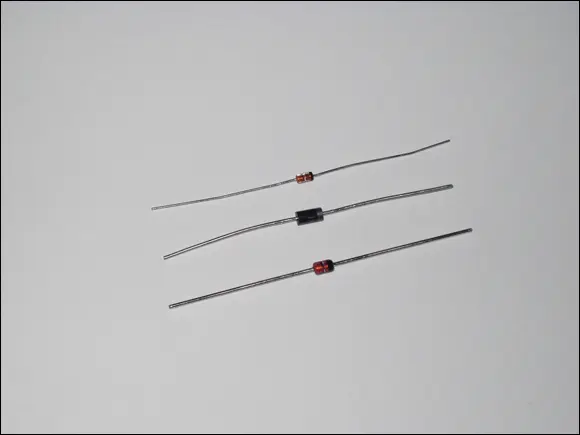
FIGURE 3-17:An assortment of diodes.
A diode has two terminals, called the anode and the cathode. Current will flow through the diode only when positive voltage is applied to the anode and negative voltage to the cathode. If these voltages are reversed, current will not flow.
You learn all about diodes in Book 2, Chapter 5. For now, I suggest you get at least five of the basic diodes known as the 1N4001 (the middle one in Figure 3-17). You should be able to find these at any electronics parts distributor.
A light-emitting diode (or LED ) is a special type of diode that emits light when current passes through it. You learn about LEDs in Book 2, Chapter 5. Although there are many different types of LEDs available, I suggest you get started by purchasing at least five red diodes. Figure 3-18 shows a typical red LED.
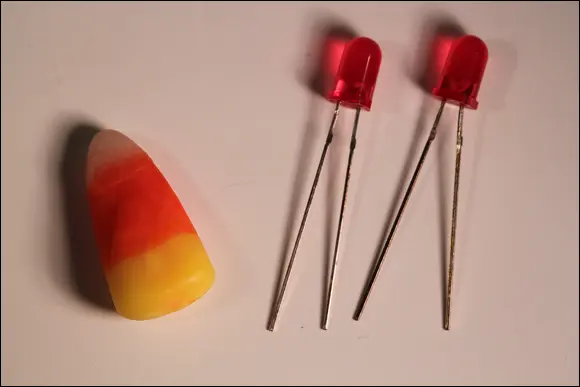
FIGURE 3-18:Light-emitting diodes.
A transistor is a three-terminal device in which a voltage applied to one of the terminals (called the base ) can control current that flows across the other two terminals (called the collector and the emitter ). The transistor is one of the most important devices in electronics, and I cover it in detail in Book 2, Chapter 6. For now, you can just get a few simple 2N3904 NPN transistors, shown in Figure 3-19, to have on hand.
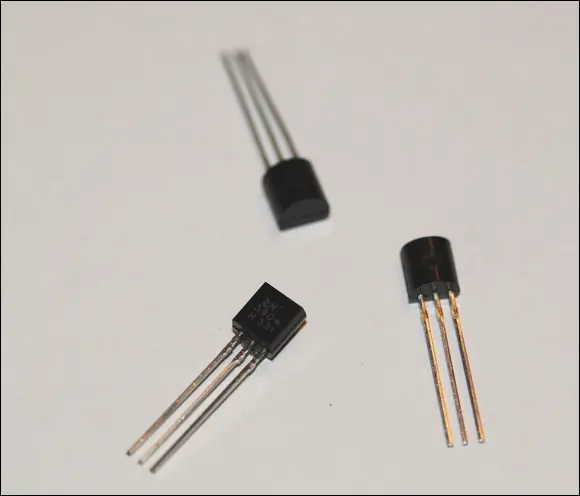
FIGURE 3-19:A look at a 2N3904 NPN transistor.
 Don’t worry; by the time you finish Book 2, Chapter 6, you’ll know what the designation 2N3904 NPN means.
Don’t worry; by the time you finish Book 2, Chapter 6, you’ll know what the designation 2N3904 NPN means.
An integrated circuit is a special component that contains an entire electronic circuit, complete with transistors, diodes, and other elements, all photographically etched onto a tiny piece of silicon. Integrated circuits are the building blocks of modern electronic devices such as computers and cellphones.
You learn how to work with some basic integrated circuits in Book 3. To get started, you’ll want to pick up a few each of at least two different types of integrated circuits: a 555 timer and an LM741 op-amp. These chips are shown in Figure 3-20.
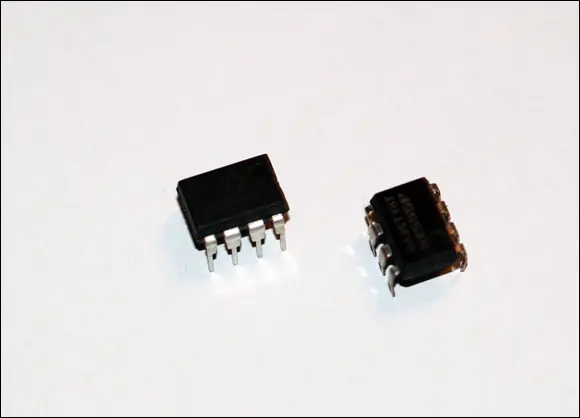
FIGURE 3-20:Two popular integrated circuits: A 555 timer and an LM741 op-amp.
There is, of course, one last thing your mad-scientist lab will need to make it complete. That one last thing is a sign that properly warns your friends and family that you are indeed a mad scientist. You have my express permission to photocopy the sign, shown in Figure 3-21, and place it in a prominent spot near your workbench.
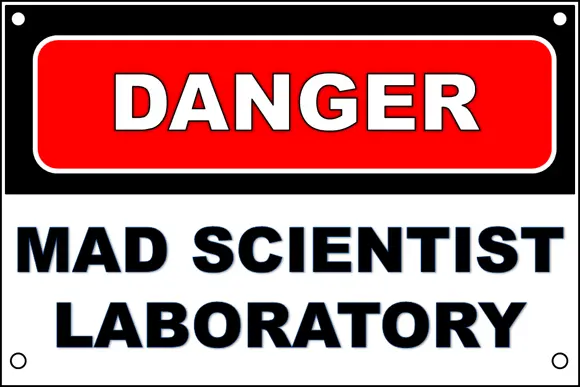
FIGURE 3-21:Make sure your friends and family are properly warned.
Chapter 4
IN THIS CHAPTER
 Knowing the risks of working with electricity
Knowing the risks of working with electricity
 Protecting yourself from the perils of stray electricity
Protecting yourself from the perils of stray electricity
 Safeguarding your gear from static electricity
Safeguarding your gear from static electricity
When I was a kid, I helped a good friend named Barry who built a Tesla coil. By “helped,” I mean that I hung out in his garage and watched while he meticulously wrapped thousands of turns of bare copper wire around a huge glass milk bottle, painted it with dozens of coats of lacquer, and polished the brass ball that attached to the very top of the coil. I’m quite certain he couldn’t have done it without me.
When it was done, we plugged it in and marveled at what it could do. Sparks flew at random a foot or two into the air from the ball at the top of the coil. If you held a crowbar in one hand, you could draw a spark several feet from the ball to the crowbar. The current coming off the ball flew through the air and into the crowbar, and then passed through our bodies and into the ground. You could also light up a fluorescent light tube simply by holding the tube in your hand within a few feet of the coil.
To this day, I cannot believe Barry’s parents let him build it. I know my parents wouldn’t have let me build one. My mom was kind of like the mom in A Christmas Story, who wouldn’t let her son Ralphie have a Red Ryder BB gun (the one with a compass in the stock and this thing that tells time) because “you’ll shoot your eye out.”
That was my mom. No Tesla coils for me. Too dangerous.
None of the electronic projects described in this book are anywhere near as dangerous as a Tesla coil. In fact, most of them pose no threat at all. That being said, it’s important to remember that whenever you’re working with electricity, you’re working with something that’s potentially very dangerous.
The possibility of electric shock is always present whenever you work with electricity, but there are other potential dangers as well. You probably won’t shoot your eye out, but if you’re not careful, you might start a fire or otherwise injure yourself or someone else.
The purpose of this chapter, then, is to keep you safe while you experiment with electronics. Please read it well, and please heed every bit of advice I give here.
Читать дальше
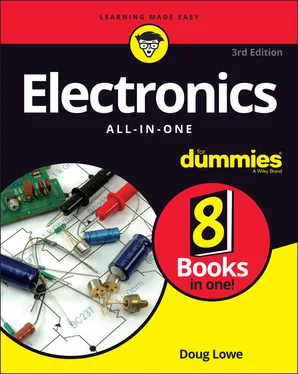

 As with resistors, you can purchase kits with a wide variety of assorted capacitor values. For about $15, you can get 500 or more capacitors in a range of useful values.
As with resistors, you can purchase kits with a wide variety of assorted capacitor values. For about $15, you can get 500 or more capacitors in a range of useful values.


 Don’t worry; by the time you finish Book 2, Chapter 6, you’ll know what the designation 2N3904 NPN means.
Don’t worry; by the time you finish Book 2, Chapter 6, you’ll know what the designation 2N3904 NPN means.

 Knowing the risks of working with electricity
Knowing the risks of working with electricity










